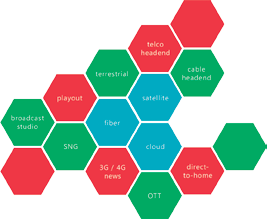In order to be successful, broadcasters and service providers require velocity, scalability and cost structures that unify the various media workflows that cross technology and vendor boundaries of satellite, fiber and cloud infrastructures.

Thee Key Industry Trends
The broadcast and media service provider industry is going through a number of transitions. Customers are more demanding than ever before, technology is evolving at a rapid pace and there is increasing pressure to run businesses far more efficiently.
Network Management Systems (NMS) and Operational Support Systems (OSS) are instrumental in delivering the customer experience at the correct cost, turning end-to-end NMS/OSS into a highly strategic asset for any media company, broadcaster, satellite operator and service provider.
Trend 1: Businesses + Value Chains Are Changing
The broadcast and service provider landscape is changing quickly. Consumers expect content to be available at any screen in any location and they want the choice to consume the experience at their own convenience. Live content is still king—consumers want the option to watch, interact via social media and even generate their own content in real time. Time is of the essence. Advertisers drive broadcasters and service providers to adapt to the evolving consumption behavior.
The industry responds well to the needs of the consumer and the advertising industry. Broadcasters and service providers deploy new services to retain customers in an ever-increasingly competitive environment. 4K UHDTV, multi-screen, OTT, TSTV, network DVR, targeted ads, social media embedded with traditional video-these are just a few examples of new experiences offered to consumers. The wealth of new services reduces churn, at least as long as there is good content that is always available.
The rapid growth of new services and products places high pressure on the operational and capital expenditures of media companies. The costs are high as well as the risk, as not all new services are equally well adopted by consumers.
As a result, companies that are just starting get to use new hardware and software solutions and are also able to explore new business and operational models. xAAS and VNO models are selected to reduce risk and cost and such models, in turn, enable new businesses to incubate. These new business models create a new dimension of operating services and infrastructure.
Today’s media networks continuously converge and evolve. Multiple technologies from different brands co-exist, each having their own strengths. The challenge is to have all technologies work together in one orchestrated manner.
Trend 2: Efficiency Is Of The Essence
An efficient network is a network that supports end-to-end unified media workflows, regardless of which network technology is used and regardless of the brand of equipment.
Software and hardware from multiple vendors need to interoperate, acting as one converged network, supporting MPEG-2, H.264 and HEVC, live and file media, linear and non-linear exchanges, satellite, fiber SDH, MPLS, traditional processing and cloud virtual functions. Furthermore, the highest degree of efficiency is reached if multiple applications share the same infrastructure: contribution, exchange, distribution and OTT, data, video, audio, voice, interactive applications, advertising, etc. In such a dynamically shared network, managing resources must be embedded in a company’s day-to-day activities. No longer accepted are network idle time and resource under-utilization.

Going one step further, new cloud resource management paradigms arise, such as overbooking, last minute capacity extensions, taking the best of what is on hand, and so on. Indeed, the media industry adopts experiences from the IT industry: all-IP networking over any medium, generic CPU-based media transcoding and processing using Virtualized Media Functions (VMF) in the cloud, increased use of file formats and file exchanges driven by cost-effective storage and overnight transfers.
Trend 3: Vendors Offer API’s Instead Of NMS/OSS
As most are aware, technology is rapidly evolving. This means there is a growing need to reduce complexity in an ever more dynamic and complex environment. While in the past, technology providers sold EMS/NMS systems capable of managing their entire ecosystem as part of their product portfolio, today, the focus on those products is often reduced and scaled down to uniquely managing their own brands of equipment.
Vendors offer APIs, thereby freeing up resources to develop their core technology rather than NMS/OSS, as the latter is most often not part of the core product strategy. Fortunately, open and documented APIs offer additional advantages: the ability to manage all devices, subsystems, services, and SLAs from one single view, following one set of operational processes, and using one set of unified workflows across the company. As such, operators recognize the value of using a using a technology independent, multi-vendor NMS/OSS that is highly configurable to their needs and to the way they operate the network and services.
NMS/OSS Strategic Assets
Today’s media infrastructure is an aggregate of many different technologies, interoperating using standard interfaces (ASI, SDI, ETH and others), transmission protocols (IP, UDP, RTP, SMPTE2020 and others), compression formats (JPEG2000, MPEG-2, H.264, HEVC and so on) and file formats and containers (MXF, and more). Exchanging media using open-standard interfaces works well in practice.

But even if video and data can seamlessly be exchanged across a variety of technologies supplied by different vendors, network and video processing segments are still often operated in isolation, thereby not unleashing the true potential of running a complete infrastructure as one single, shared entity. What is needed to provide operators the velocity, scalability and cost structure are end-to-end media workflows that are agnostic to type of technology and brand of equipment.
Using DataMiner NMS/OSS, boundaries between media capture, video processing, transmission and storage are disappearing. The technology to enable this is based on four pillars of innovation:
First is the fact that DataMiner is the unique system that manages and controls just any resource and technology in the network : legacy devices, data centers, Virtualized Media Functions (VMF) and even bandwidth.
Second is the new robust resource booking, reservation and advanced activation that enables end-to-end workflow automation in a comprehensive manner.
Third are the unified and integrated NMS/OSS gateway functions, such as automated trouble ticket generation and real-time customer self-service portals, which simplify and unify operational processes regardless of which technology used.
Forth, and last, is that DataMiner keeps track of all historical events and learns from it (big data analytics), thereby predicting network performance and outages in a pro-active manner.

A Perfect Fit
DataMiner is operational at more than 500 media companies around the world. Multiple applications are supported as a result of the numerous configuration capabilities at all levels. Whether you are a broadcaster, satellite operator or service provider in the cable, telco, mobile or satellite industry, DataMiner manages your networks, your services and SLA’s.http://www.skyline.be/
http://www.dataminer.co/
Steven Soenens is an experienced professional in product marketing, product management and engineering of multiscreen video compression and transmission solutions for the broadcast, satellite, cable and telco industries.
At present, Steven is responsible for product marketing of DataMiner with Skyline Communications.


